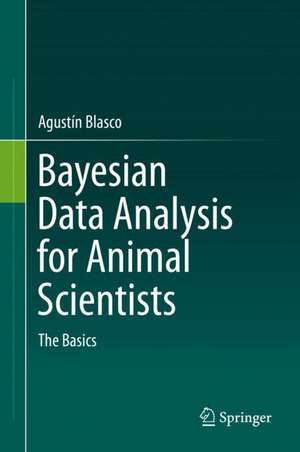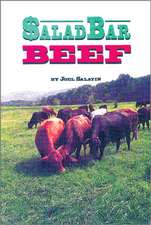Bayesian Data Analysis for Animal Scientists: The Basics
Autor Agustín Blascoen Limba Engleză Hardback – 14 sep 2017
| Toate formatele și edițiile | Preț | Express |
|---|---|---|
| Paperback (1) | 473.69 lei 38-44 zile | |
| Springer International Publishing – 10 aug 2018 | 473.69 lei 38-44 zile | |
| Hardback (1) | 734.44 lei 3-5 săpt. | |
| Springer International Publishing – 14 sep 2017 | 734.44 lei 3-5 săpt. |
Preț: 734.44 lei
Preț vechi: 895.66 lei
-18% Nou
Puncte Express: 1102
Preț estimativ în valută:
140.55€ • 146.20$ • 116.03£
140.55€ • 146.20$ • 116.03£
Carte disponibilă
Livrare economică 24 martie-07 aprilie
Preluare comenzi: 021 569.72.76
Specificații
ISBN-13: 9783319542737
ISBN-10: 3319542737
Pagini: 302
Ilustrații: XVIII, 275 p. 160 illus., 151 illus. in color.
Dimensiuni: 155 x 235 x 21 mm
Greutate: 0.64 kg
Ediția:1st ed. 2017
Editura: Springer International Publishing
Colecția Springer
Locul publicării:Cham, Switzerland
ISBN-10: 3319542737
Pagini: 302
Ilustrații: XVIII, 275 p. 160 illus., 151 illus. in color.
Dimensiuni: 155 x 235 x 21 mm
Greutate: 0.64 kg
Ediția:1st ed. 2017
Editura: Springer International Publishing
Colecția Springer
Locul publicării:Cham, Switzerland
Cuprins
Foreword.- Notation.- 1. Do we understand classical statistics?.- 2. The Bayesian choice.- 3. Posterior distributions.- 4. MCMC.- 5. The “baby” model.- 6. The linear model. I. The “fixed” effects model.- 7. The linear model. II. The “mixed” model.- 8. A scope of the possibilities of Bayesian inference + MCMC.- 9. Prior information.- 10. Model choice.- Appendix.- References.
Notă biografică
Agustin Blasco
Professor of Animal Breeding and Genetics
Visiting scientist at ABRO (Edinburgh), INRA (Jouy en Josas) and FAO (Rome). He was President of the World Rabbit Science Association and editor in chief of the journal World Rabbit Science. His career has focused on the genetics of litter size components and genetics of meat quality in rabbits and pigs. He has published more than one hundred papers in international journals. Invited speaker several times at the European Association for Animal Production and at the World Congress on Genetics Applied to Livestock Production among others. Chapman Lecturer at the University of Wisconsin. He has taught courses on Bayesian Inference at the universities of Valencia (Spain), Edinburgh (UK), Wisconsin (USA), Padua (Italy), Sao Paulo, Lavras (Brazil), Nacional (Uruguay), Lomas (Argentina) and at INRA in Toulouse (France).
Professor of Animal Breeding and Genetics
Visiting scientist at ABRO (Edinburgh), INRA (Jouy en Josas) and FAO (Rome). He was President of the World Rabbit Science Association and editor in chief of the journal World Rabbit Science. His career has focused on the genetics of litter size components and genetics of meat quality in rabbits and pigs. He has published more than one hundred papers in international journals. Invited speaker several times at the European Association for Animal Production and at the World Congress on Genetics Applied to Livestock Production among others. Chapman Lecturer at the University of Wisconsin. He has taught courses on Bayesian Inference at the universities of Valencia (Spain), Edinburgh (UK), Wisconsin (USA), Padua (Italy), Sao Paulo, Lavras (Brazil), Nacional (Uruguay), Lomas (Argentina) and at INRA in Toulouse (France).
Textul de pe ultima copertă
In this book, we provide an easy introduction to Bayesian inference using MCMC techniques, making most topics intuitively reasonable and deriving to appendixes the more complicated matters. The biologist or the agricultural researcher does not normally have a background in Bayesian statistics, having difficulties in following the technical books introducing Bayesian techniques. The difficulties arise from the way of making inferences, which is completely different in the Bayesian school, and from the difficulties in understanding complicated matters such as the MCMC numerical methods. We compare both schools, classic and Bayesian, underlying the advantages of Bayesian solutions, and proposing inferences based in relevant differences, guaranteed values, probabilities of similitude or the use of ratios. We also give a scope of complex problems that can be solved using Bayesian statistics, and we end the book explaining the difficulties associated to model choice and the use of small samples. The book has a practical orientation and uses simple models to introduce the reader in this increasingly popular school of inference.
Caracteristici
An easy and intuitive introduction to Bayesian methods with Monte-Carlo Markov Chain methods (MCMC) The author uses colours to help the understanding of the formulae and numerous graphs to make the inferences more intuitive Examples are taken from published papers and common problems in the field of biology and agriculture New ways of expressing uncertainty are proposed, to help researchers derive conclusions from their experiments Includes supplementary material: sn.pub/extras




